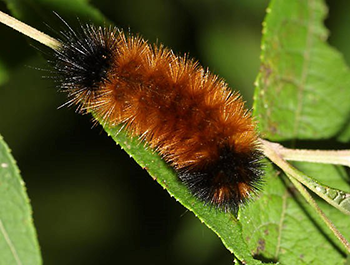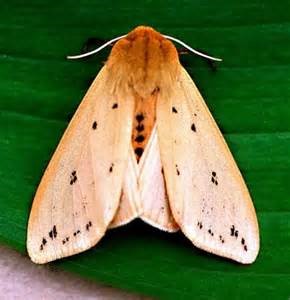Taking an environmentally sensitive approach to pest management
Wintery Weather Folklore
Published: November 11, 2014

Figure 1. Woolly bear (Pyrrharctia isabella) caterpillar. Photo credit: Bugguide.net
The infamous woolly bear (Pyrrharctia isabella) caterpillars are on the move, seeking a sheltered spot for the winter (Figure 1). At one time or another, most of us have heard the myths that this caterpillar is a predictor of the coming winter weather. One version of the myth is that longer black bands of setae (hairs) on the caterpillar is an indicator of an upcoming harsh winter, but shorter black sections signify mild winter conditions. Another version of the myth is that woolly bear caterpillars crawl in a southerly direction in an attempt to escape an impending bitter winter, whereas those heading north indicate a mild winter. Yet a third version is that a dark head capsule is predictor of harsh weather at the beginning of winter, while a dark rear section of the caterpillar indicates that late winter conditions will be severe. Along with this, the woolly bear caterpillar has thirteen body segments, which supposedly correspond to the length of winter.
Apparently, these myths have circulated for centuries. However, these types of myths spread dramatically when a story was published in the New York Herald Tribune in 1948. Dr. Howard Curran, an entomologist for the American Museum of Natural History, traveled to Bear Mountain State Park, New York with some friends and conducted a small study. The brown bands on 15 caterpillar specimens were noted and he subsequently made a prediction about the upcoming winter based on these popularized results.

Figure 2. Adult moth of Pyrrharctia isabella found in the summer. Photo credit: Bugguide.net
In fact, the color bands on the woolly bear caterpillar indicate its life stage. These caterpillars molt six times before they become adults. With each molt, the coppery-brown mid-section becomes progressively longer. Interestingly, these caterpillars can survive extremely low temperatures (-90°F). After overwintering, woolly bear caterpillars feed in the spring, form a cocoon made from their setae, and pupate. About two weeks later, the yellow-orange moth (also known as the Isabella tiger moth) with a 1¾ to 2¼ inch wing-span emerge and are found from early April through September.
While it is tempting to handle these fuzzy caterpillars, the setae can cause a dermatitis-type reaction in some. However, unlike some other caterpillars, the woolly bear’s setae do not contain a substance that often results in a very painful sting. Regardless of the myths, woolly bear caterpillars are prevalent in fall and are a fun way to speculate about winter!
Subscribe to receive similar articles sent directly to your inbox!
- Winter Plant Protection (12/03/24)
- Melons: An August Treat (08/06/24)
- Winter Care of Hardy Mums (11/09/23)
REVISED: September 29, 2015